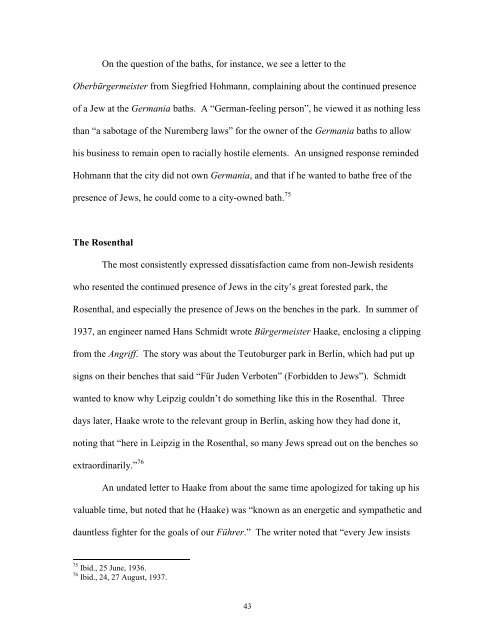Jews in Leipzig - The University of Texas at Austin
Jews in Leipzig - The University of Texas at Austin
Jews in Leipzig - The University of Texas at Austin
Create successful ePaper yourself
Turn your PDF publications into a flip-book with our unique Google optimized e-Paper software.
On the question <strong>of</strong> the b<strong>at</strong>hs, for <strong>in</strong>stance, we see a letter to the<br />
Oberbürgermeister from Siegfried Hohmann, compla<strong>in</strong><strong>in</strong>g about the cont<strong>in</strong>ued presence<br />
<strong>of</strong> a Jew <strong>at</strong> the Germania b<strong>at</strong>hs. A “German-feel<strong>in</strong>g person”, he viewed it as noth<strong>in</strong>g less<br />
than “a sabotage <strong>of</strong> the Nuremberg laws” for the owner <strong>of</strong> the Germania b<strong>at</strong>hs to allow<br />
his bus<strong>in</strong>ess to rema<strong>in</strong> open to racially hostile elements. An unsigned response rem<strong>in</strong>ded<br />
Hohmann th<strong>at</strong> the city did not own Germania, and th<strong>at</strong> if he wanted to b<strong>at</strong>he free <strong>of</strong> the<br />
presence <strong>of</strong> <strong>Jews</strong>, he could come to a city-owned b<strong>at</strong>h. 75<br />
<strong>The</strong> Rosenthal<br />
<strong>The</strong> most consistently expressed diss<strong>at</strong>isfaction came from non-Jewish residents<br />
who resented the cont<strong>in</strong>ued presence <strong>of</strong> <strong>Jews</strong> <strong>in</strong> the city’s gre<strong>at</strong> forested park, the<br />
Rosenthal, and especially the presence <strong>of</strong> <strong>Jews</strong> on the benches <strong>in</strong> the park. In summer <strong>of</strong><br />
1937, an eng<strong>in</strong>eer named Hans Schmidt wrote Bürgermeister Haake, enclos<strong>in</strong>g a clipp<strong>in</strong>g<br />
from the Angriff. <strong>The</strong> story was about the Teutoburger park <strong>in</strong> Berl<strong>in</strong>, which had put up<br />
signs on their benches th<strong>at</strong> said “Für Juden Verboten” (Forbidden to <strong>Jews</strong>”). Schmidt<br />
wanted to know why <strong>Leipzig</strong> couldn’t do someth<strong>in</strong>g like this <strong>in</strong> the Rosenthal. Three<br />
days l<strong>at</strong>er, Haake wrote to the relevant group <strong>in</strong> Berl<strong>in</strong>, ask<strong>in</strong>g how they had done it,<br />
not<strong>in</strong>g th<strong>at</strong> “here <strong>in</strong> <strong>Leipzig</strong> <strong>in</strong> the Rosenthal, so many <strong>Jews</strong> spread out on the benches so<br />
extraord<strong>in</strong>arily.” 76<br />
An und<strong>at</strong>ed letter to Haake from about the same time apologized for tak<strong>in</strong>g up his<br />
valuable time, but noted th<strong>at</strong> he (Haake) was “known as an energetic and symp<strong>at</strong>hetic and<br />
dauntless fighter for the goals <strong>of</strong> our Führer.” <strong>The</strong> writer noted th<strong>at</strong> “every Jew <strong>in</strong>sists<br />
75 Ibid., 25 June, 1936.<br />
76 Ibid., 24, 27 August, 1937.<br />
43

















